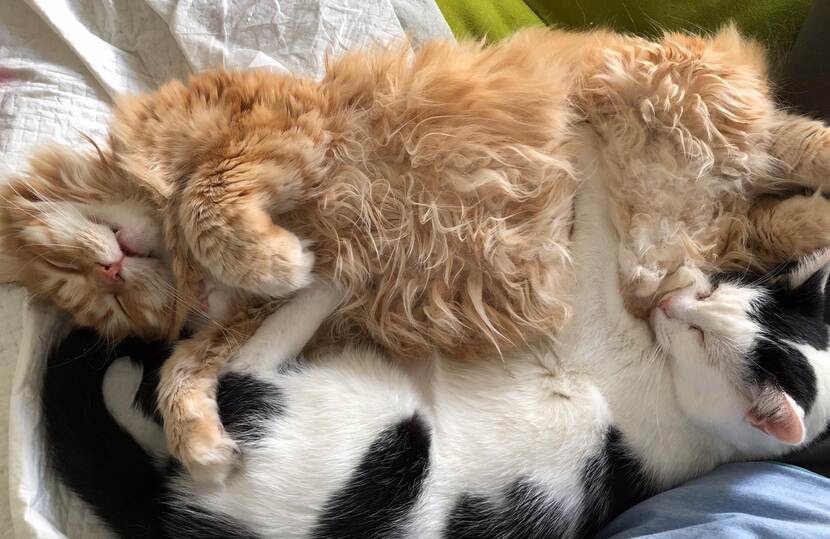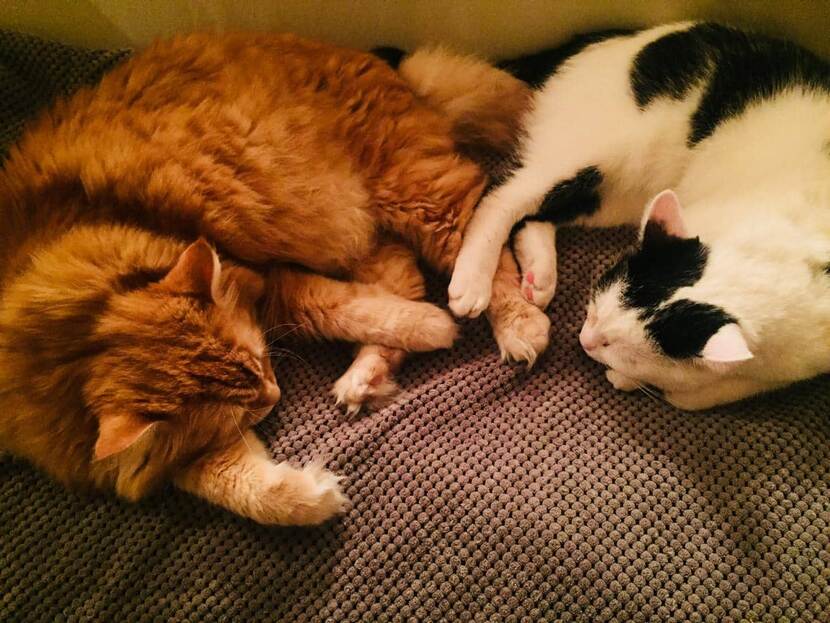Taking your cat(s) to EU 2019
In August 2019 Carolien Spaans, Agricultural Counsellor of the Netherlands in Ukrane, moved to her new posting in Warsaw with 2 cats, which she adopted in Kyiv. Here is her personal story on how to travel with cats from Ukraine to EU.

Bernard and Roxy
August 2019, Kyiv - >Warsaw
Below is my experience on all the steps that are necessary to take your cat(s) from Ukraine to the EU. I travelled by car, so when you go by plane, the required documents in itself are the same but make sure to check the requirements from your airline company when it comes to transporting the cats such as for the carrier.
Important is to start preparations at least 4 months before your departure. If you want to take care of everything without stress, 5 months before is better.
The official regulations from the EU in order to import your cat(s) from a third country with high rabies risk (=Ukraine) can be found on their website. Since requirements might change, it is important to check the website to see which boxes you need to tick off https://ec.europa.eu/food/animals/pet-movement/eu-legislation/non-commercial-non-eu_en
Following the necessary requirements of the EU in July 2019, you have to take the following steps:
- Make sure the cat(s) are microchipped. This needs to be done before the rabies vaccinations.
- Register the cats with their microchip number both in Animal ID (animal-id.info) and in Tracer (tracer.com.ua). In case you got your cat(s) from the shelter, they should be able to help you since they are till that point the official owner of the cat.
- Get the latest official passport for the cat(s). Old Ukrainian passports are not valid anymore for travelling to the EU. Passports can be obtained at the official veterinary clinic in Kyiv located on Volynska street №12 (Волинська вул., 12, Kyiv, Kyiv Oblast). You need to bring your cat(s) so they can read the microchip in order to check whether the cats match the registration. You do not need to make an appointment beforehand, but make sure to check the opening times since they also have lunch breaks. Best to come in the morning (starting from 10 am). You can find the entrance to the office when you go into the courtyard where also the state clinic is located, but then move around to the back of the building, go inside, 2nd floor, to the left.
- In case the cats had the old passports; don’t throw them away since there is information in there about previous vaccinations and or checks. They might ask for them at the border (both Ukrainian and Polish side).
For the following two steps you can also ask your vet for a home visit in order to reduce the stress for your cat(s). You will need to pay for the taxi fair and tip the vet.
- Vaccinate the cat against rabies and echinococcus (cat disease). Depending on whether your cat has had rabies vaccination before, it is one shot or can be a sequence of shots.
- 30 days after the last rabies vaccination (or later, but not before), a test should be done to test the antibodies for rabies. The vet needs to withdraw blood for this from the cat. The blood will be send to the official lab in Kyiv. You will receive a message when the results are in and you can pick it up. The address of the lab where you pick up the results is Mykola Shpaka street №3 in Kyiv. They are open from 10 a.m. till 8 p.m.
- Counting from the date that the blood was drawn for the antibodies test, you have to wait three calendar months before you can take the cat(s) to the EU + (this in contrary to EU requirements) you need to count the days as well of step 9. This is also why you have to start in time with preparations!
Prepare the documents:
- The results of the test for antibodies needs to be added in the passport of the cat(s), also hold on to the official result itself.
- Take the cats with passports + test result from the lab for antibodies for rabies to the veterinarian on Volynska street. In contrary to the EU requirements, do this between 1 and 5 days before your departure (they prefer three days, weekend days are included in the counting of the number of days).
- The vet will check the health of the cats (the procedure is brief, (s)he will have a look and might check microchip again and will need to write in the passport that they are healthy.
- When I departed, a new procedure for getting the EU health certificate was being set up, but not functioning yet. In case it is functioning, you will receive a EU health certificate for the cats at the vet itself with which you can cross the border. You will have to pay for this. There is one part in cash, one part which needs to paid via the bank (if you don’t have a local bank account, ask someone to do it for you). In case the new procedure doesn’t function you will receive a F1 form which you will need to change at the border.
- Print yourself (form is at the EU website) the owner declaration in which you state that you are not going to sell the cats.
Border crossing:
- Choose a border crossing which is a so called BIP (veterinary Border Inspection Post). You can find the whole list here https://ec.europa.eu/food/animals/vet-border-control/bip_en
- If you didn’t receive the EU health certificate yet; announce at the Ukrainian side of the border that you have cats and they will send a veterinarian to you / you will go to his office. The veterinarian which was there in my case, just looked at the cats while still in the car in their carrier and asked for age. But they might ask you to take the cats to the office for reading of the microchip.
- The veterinarian at the border will exchange the F1 form for the EU health certificate (and add stamps) against a cash payment.
- You will go to the Polish side of the border, having with you:
- Most important, the microchipped cats.
- New passports. In their passports there is: owners name, description of the cats, sticker with microchip number, date of their anti rabies vaccination + anti echinococcus, test result of antibodies for rabies test, declaration that they are healthy. With stamps.
- In case the cat(s) previously had old Ukrainian passports, take them as well.
- Official results of blood test antibodies for rabies from the lab.
- EU health certificate with stamps.
- EU owner declaration.
- Positive energy and a smile
- You announce you have cats at the Polish border guard. If you are lucky; no problem, no checks, just carry on and drive into EU. Or, a veterinarian will check cats + all their papers.
Please note that the veterinarians working at the state clinic in Kyiv as well as the border have no to very limited understanding of English. In case you have limited understanding of Ukrainian, arrange a backup by phone (colleague / friend) who can translate for you in case things get complicated. Because it might ;-)
August 2019, Kyiv - Warsaw
